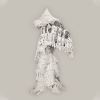No. 2

No. 2 (Number 2) is a series of model studies of objects to induce comfort of homeless individuals on the streets. The project used HDPE plastic bags, with the title based on the RIC (Resin Identification Code) of the material and, at the same time, the essence of recycling.
Gallery
Student
Jose Ruel V Bozzolo-Fabia
Faculty
Term
ARC 632, Fall 2018
Program
MArch – Material Culture
City life is always accompanied by sporadic interactions with homeless people lingering on the streets, in transportation hubs, or other various public spaces. Due to their appearance, they are often misrepresented as useless members of society.
Homelessness in metropolitan areas is caused by several factors, such as lack of affordable housing, mental illnesses, substance abuse, and low-paying jobs. Being victims of these circumstances, homeless people thrive on being “bottom feeders,” collecting plastic and glass bottles from the streets which are sold to recycling centers for money, so they may later buy food. Their mode of survival has become vital in creating a cleaner landscape. While their need for nutrition has received aid, another layer of physiological necessity is yet to be solved—shelter.
My work is a projection of myself...combining design with other artistic forms only makes it more robust.
– Fab Fabia
A contemplation of urbanite survival based on primitive life hack–No. 2 (Number 2) is a series of model studies of objects to induce comfort of homeless individuals on the streets. The project used HDPE plastic bags, with the title based on the RIC (Resin Identification Code) of the material and, at the same time, the essence of recycling. The project explores specific strategies related to the tectonics of the knot and weaving, as a condition that brings together basic constructive traditions with contemporary architectural production. Establishing a bridge between the intellectual and the physical, the project and the course explore material practices leading to architectural solutions, applied to the constructive and the emotional alike.
No. 2 is composed of three woven pieces, which protect an urban nomad from the harsh life in the city. Through the re-use of plastic bags, each object manifests a variety of interventions and differences in texture using the most abundant material in the city. Before the development of agriculture, humans thrived on migrating to where resources were abundant. In cities, the urban nomad functions in the same way as their predecessors, by gathering re-sellable items or trinkets that evoke an emotional connection to them beyond physiological needs. With this, a multipurpose container for survival is made.



